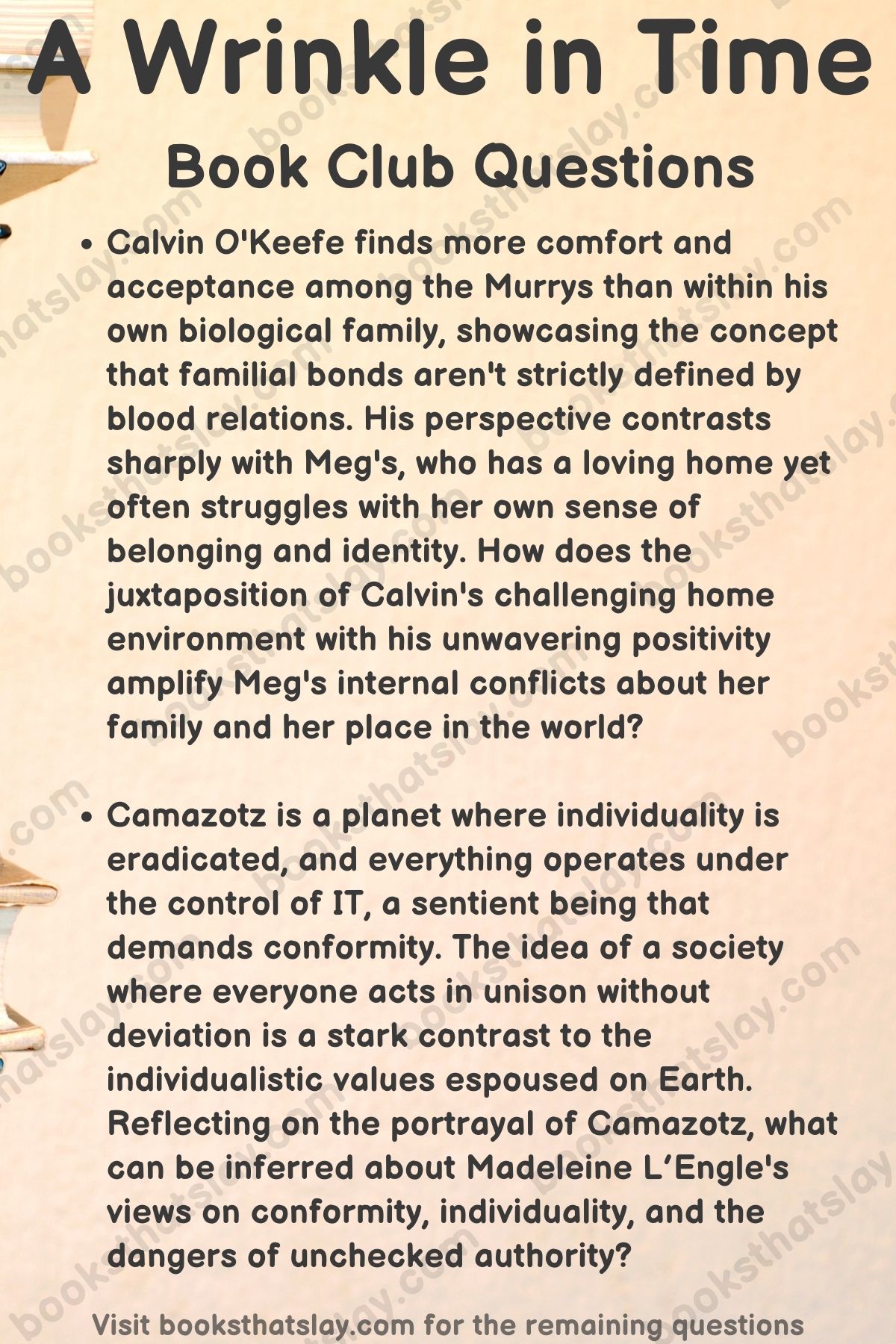10 A Wrinkle in Time Book Club Questions For Discussion
Madeleine L’Engle’s “A Wrinkle in Time” is not just a journey across the universe but also a deep dive into the complexities of the human spirit. This timeless tale, while set against the backdrop of cosmic battles between light and darkness, is fundamentally about love, self-worth, family, and the courage to confront one’s fears.
But beneath its science fiction trappings, the novel raises profound philosophical and moral questions that resonate with readers of all ages.
Whether you’re revisiting this classic or sharing it with a new generation, these book club questions for A Wrinkle in Time aim to spark deeper reflection and understanding in your discussion sessions.
So, let’s journey together into the intricate layers of L’Engle’s masterpiece and discover the universe within its pages and within ourselves.

A Wrinkle in Time Book Club Questions
- Throughout the novel, we see Meg Murry’s transformation from a self-loathing adolescent into a determined young woman ready to face cosmic evil for her family. She deals with personal insecurities, learns about the complex nature of the universe, and finally discovers the power of love.
How does Meg’s understanding of herself and her relationships, especially with her father, change throughout her journey, and what are the pivotal moments that catalyze these changes? - Charles Wallace’s unique gifts and intelligence allow him to perceive and understand the world in ways most others can’t. He chooses to hide these gifts from the world to avoid unwanted attention and potential ostracization.
How does Charles Wallace’s decision to conceal his exceptional abilities reflect broader societal issues related to the treatment and perception of gifted or “different” individuals? - The tesseract is introduced early in the story as something mysterious, with even Mrs. Murry being shocked at its mention. As a fifth-dimensional phenomenon, it represents a form of travel that defies conventional understanding and introduces the characters to the vastness and mysteries of the universe.
In what ways does the idea of tesseracting challenge the characters’ understanding of reality and how might it symbolize broader themes about human comprehension and exploration? - Calvin O’Keefe finds more comfort and acceptance among the Murrys than within his own biological family, showcasing the concept that familial bonds aren’t strictly defined by blood relations. His perspective contrasts sharply with Meg’s, who has a loving home yet often struggles with her own sense of belonging and identity.
How does the juxtaposition of Calvin’s challenging home environment with his unwavering positivity amplify Meg’s internal conflicts about her family and her place in the world? - Mrs. Whatsit, Mrs. Who, and Mrs. Which, play significant roles as guides and mentors for Meg, Charles Wallace, and Calvin. These celestial beings have insights into the universe, offer cryptic advice, and guide the young protagonists on their interplanetary quests.
Considering their various interactions and the wisdom they impart, how do these characters shape the trio’s understanding of good, evil, and personal strength? - Throughout the narrative, Mrs. Whatsit plays a pivotal role in Meg’s journey, both emotionally and physically. She often steps in to provide comfort, especially in the absence of Meg’s father. Given Mrs.
Whatsit’s dynamic with Meg and her evolution from a comforting to a challenging figure, how does she embody the transformative nature of guardianship and mentorship, emphasizing the importance of tough love in personal growth? - Camazotz is a planet where individuality is eradicated, and everything operates under the control of IT, a sentient being that demands conformity. The idea of a society where everyone acts in unison without deviation is a stark contrast to the individualistic values espoused on Earth.
Reflecting on the portrayal of Camazotz, what can be inferred about Madeleine L’Engle’s views on conformity, individuality, and the dangers of unchecked authority? - In the climax of the story, Meg realizes that the one thing she possesses, which IT does not, is love. This powerful emotion becomes her weapon and salvation. Throughout literature and human history, love has been depicted as a transformative and redeeming force.
How does the novel position love as a counter to darkness and control, and what does this suggest about L’Engle’s perspective on human connections and their place in the universe? - When the protagonists find themselves on Ixchel, they encounter beings that have evolved without the sense of sight, prioritizing other senses to comprehend their environment. This stands as a profound metaphor for understanding things not merely based on their visual representation but for their true essence.
Considering Meg’s interactions with Aunt Beast, in what ways does the novel challenge our conventional modes of perception and understanding, and how does this reshape our definition of reality? - Throughout her journey, Meg undergoes a deep transformation from a child seeking solace and solutions in her father’s presence to a young adult realizing that certain battles must be fought alone. Her growing realization that her father, despite his wisdom, is not omnipotent forces her to confront her own vulnerabilities and potential.
What are the pivotal moments in the story that catalyze Meg’s transition towards self-reliance, and how does this transition reflect the broader theme of individual growth in the face of adversity?
Check out our discussion questions for other books